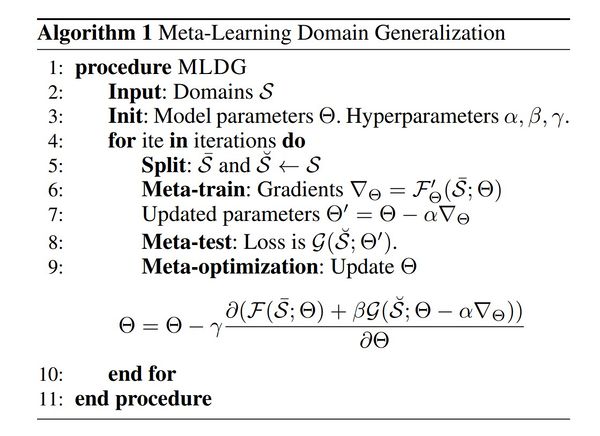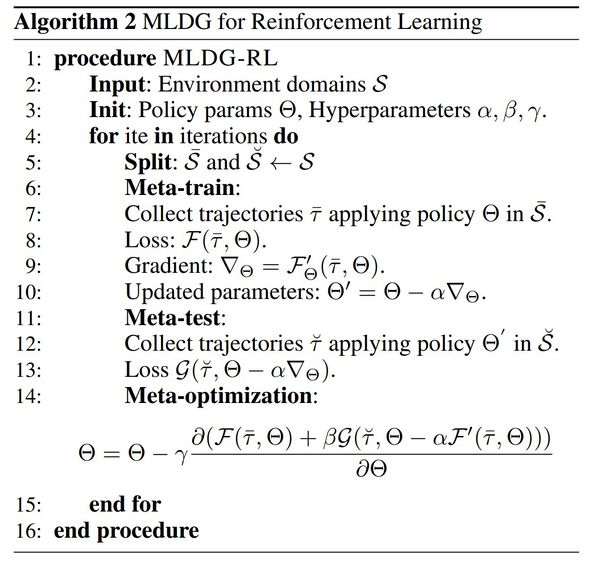Meta-Learning For Domain Generalization
Presented by
Parsa Ashrafi Fashi
Introduction
Domain Shift problem addresses the problem where a model trained on a data distribution cannot perform well when tested on another domain with different distribution. Domain Generalization tries to tackle this problem by producing models that can perform well on unseen target domains. Several approaches have been adapted for the problem, such as training a model for each source domain, extract a domain agnostic component domains and semantic feature learning. Meta-Learning and specifically Model-Agnostic Meta-Learning which have been widely adapted recently, are models capable of adapting or generalizing to new tasks and new environments that have never been encountered during training time. Here by defining tasks as domains, the paper tries to overcome the problem in a model-agnostic way.
Previous Work
There were 3 common approaches to Domain Generalization. The simplest way is to train a model for each source domain and estimate which model performs better on a new unseen target domain [1]. A second approach is to presume that any domain is composed of an domain-agnostic and a domain specific component. By factoring out the domain specific and domain-agnostic component during training on source domains, the domain-agnostic component can be extracted and transferred as a model that is likely to work on a new source domain [2]. Finally, a domain-invariant feature representation is learnt to minimize the gap between multiple source domains and it should provide a domain independent representation that performs well on a new target domain [3][4][5].
Method
In the DG setting, we assume there are S source domains [math]\displaystyle{ S }[/math] and T target domains [math]\displaystyle{ T }[/math] . We define a single model parametrized as [math]\displaystyle{ \theta }[/math] to solve the specified task. DG aims for training [math]\displaystyle{ \theta }[/math] on the source domains, such that it generalizes to the target domains. At each learning iteration we split the original S source domains [math]\displaystyle{ S }[/math] into S−V meta-train domains [math]\displaystyle{ \bar{S} }[/math] and V meta-test domains [math]\displaystyle{ \breve{S} }[/math] (virtual-test domain). This is to mimic real train-test domain-shifts so that over many iterations we can train a model to achieve good generalization in the final-test evaluated on target domains T .
The paper explains the method based on two approaches; Supervised Learning and Reinforcement Learning.
Supervised Learning
First, [math]\displaystyle{ l(\hat{y},y) }[/math] is defined as a cross-entropy loss function. ( [math]\displaystyle{ l(\hat{y},y) = -\hat{y}log(y) }[/math]). The process is as follows.
Meta-Train
The model is updated on S-V domains [math]\displaystyle{ \bar{S} }[/math] and the loss function is defined as: [math]\displaystyle{ F(.) = \frac{1}{S-V} \sum\limits_{i=1}^{S-V} \frac {1}{N_i} \sum\limits_{j=1}^{N_i} l_{\theta}(\hat{y}_j^{(i)}, y_j^{(i)}) }[/math] In this step the model is optimized by gradient descent like follows: [math]\displaystyle{ \theta^{\prime} = \theta - \alpha \nabla_{\theta} }[/math]
Meta-Test
In each mini-batch the model is also virtually evaluated on the V meta-test domains [math]\displaystyle{ \breve{S} }[/math]. This meta-test evaluation simulates testing on new domains with different statistics, in order to allow learning to generalize across domains. The loss for the adapted parameters calculated on the meta-test domains is as follows: [math]\displaystyle{ G(.) = \frac{1}{V} \sum\limits_{i=1}^{V} \frac {1}{N_i} \sum\limits_{j=1}^{N_i} l_{\theta^{\prime}}(\hat{y}_j^{(i)}, y_j^{(i)}) }[/math]
the loss on the meta-test domain is calculated using the updated parameters [math]\displaystyle{ \theta }[/math] from meta-train. This means that for optimization with respect to [math]\displaystyle{ G }[/math] we will need the second derivative with respect to [math]\displaystyle{ \theta }[/math].
Final Objective Function
Combining the two loss functions, the final objective function is as follows: [math]\displaystyle{ argmin_{\theta} \; F(\theta) + \beta G(\theta - \alpha F^{\prime}(\theta)) }[/math]. Algorithm 1 illustrates the supervised learning approach.

Reinforcement Learning
In application to the reinforcement learning (RL) setting, we now assume an agent with a policy π that inputs states x and produces actions a in a sequential decision making task: [math]\displaystyle{ a_t = \pi_{\theta}(x_t) }[/math]. The agent operates in an environment and its goal is to maximize its return, [math]\displaystyle{ R = \sum\limits_{t} \delta^t R_t(x_t, a_t) }[/math]. Here, tasks map to return functions and domains map to different environments.
Meta-Train
In meta-training, the loss function [math]\displaystyle{ F(·) }[/math]now corresponds to the negative return [math]\displaystyle{ R }[/math] of policy [math]\displaystyle{ \pi_{\theta} }[/math], averaged over all the meta-training environments in [math]\displaystyle{ \bar{S} }[/math].
Meta-Test
The step is like meta-test of supervised learning and loss is again negative of return function. For RL calculating this loss requires rolling out the meta-train updated policy <math> \theta in the meta-test domains to collect new trajectories and rewards. The reinforcement learning approach is also illustrated completely in algorithm 2.

Experiments
Results
Conclusion
Critiques
References
[1]: [Xu et al. 2014] Xu, Z.; Li, W.; Niu, L.; and Xu, D. 2014. Exploiting low-rank structure from latent domains for domain generalization. In ECCV.
[2]: [Li et al. 2017] Li, D.; Yang, Y.; Song, Y.-Z.; and Hospedales, T. 2017. Deeper, broader and artier domain generalization. In ICCV.
[3]: [Muandet, Balduzzi, and Scholkopf 2013] ¨ Muandet, K.; Balduzzi, D.; and Scholkopf, B. 2013. Domain generalization via invariant feature representation. In ICML.
[4]: [Ganin and Lempitsky 2015] Ganin, Y., and Lempitsky, V. 2015. Unsupervised domain adaptation by backpropagation. In ICML.
[5]: [Ghifary et al. 2015] Ghifary, M.; Bastiaan Kleijn, W.; Zhang, M.; and Balduzzi, D. 2015. Domain generalization for object recognition with multi-task autoencoders. In ICCV.